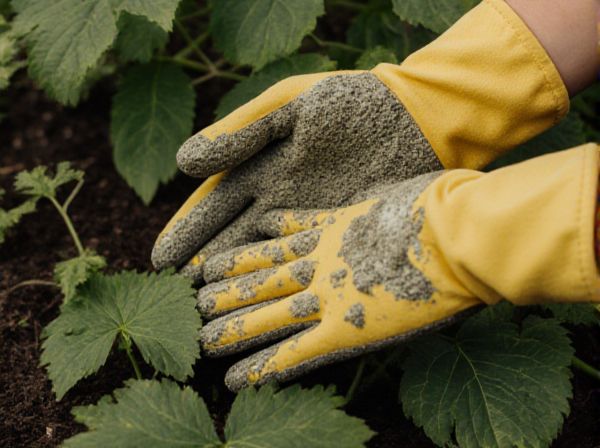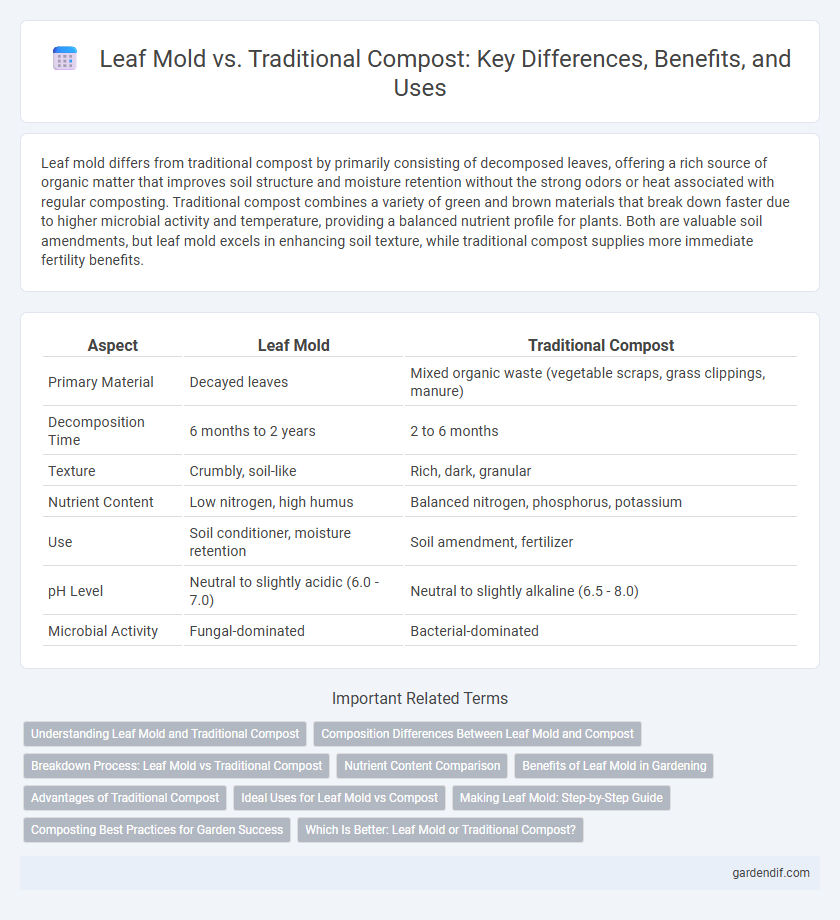
Leaf Mold vs Traditional Compost Illustration
Leaf mold differs from traditional compost by primarily consisting of decomposed leaves, offering a rich source of organic matter that improves soil structure and moisture retention without the strong odors or heat associated with regular composting. Traditional compost combines a variety of green and brown materials that break down faster due to higher microbial activity and temperature, providing a balanced nutrient profile for plants. Both are valuable soil amendments, but leaf mold excels in enhancing soil texture, while traditional compost supplies more immediate fertility benefits.
Table of Comparison
| Aspect | Leaf Mold | Traditional Compost |
|---|---|---|
| Primary Material | Decayed leaves | Mixed organic waste (vegetable scraps, grass clippings, manure) |
| Decomposition Time | 6 months to 2 years | 2 to 6 months |
| Texture | Crumbly, soil-like | Rich, dark, granular |
| Nutrient Content | Low nitrogen, high humus | Balanced nitrogen, phosphorus, potassium |
| Use | Soil conditioner, moisture retention | Soil amendment, fertilizer |
| pH Level | Neutral to slightly acidic (6.0 - 7.0) | Neutral to slightly alkaline (6.5 - 8.0) |
| Microbial Activity | Fungal-dominated | Bacterial-dominated |
Understanding Leaf Mold and Traditional Compost
Leaf mold is decomposed leaves primarily broken down by fungi, resulting in a dark, crumbly material rich in organic matter that enhances soil moisture retention and structure. Traditional compost involves a mixed decomposition of kitchen scraps, yard waste, and other organic materials by bacteria and fungi, producing nutrient-rich humus that improves soil fertility and plant growth. Understanding the distinct microbial processes and end uses of leaf mold and traditional compost helps gardeners choose the best amendment for soil health and plant needs.
Composition Differences Between Leaf Mold and Compost
Leaf mold primarily consists of decomposed leaves rich in lignin and cellulose, resulting in a dark, crumbly material with high moisture retention and excellent soil conditioning properties. Traditional compost combines various organic materials such as kitchen scraps, grass clippings, and manure, creating a nutrient-rich mix with balanced nitrogen and carbon content that promotes faster decomposition and fertility enhancement. The compositional distinction lies in leaf mold's predominance of carbon-heavy leaf matter versus traditional compost's diverse organic matter, influencing their respective nutrient profiles and soil amendment roles.
Breakdown Process: Leaf Mold vs Traditional Compost
Leaf mold breaks down slowly through fungal decomposition, transforming fallen leaves into a dark, crumbly material rich in humus and moisture-retention properties. Traditional compost relies on a faster aerobic breakdown process involving bacteria, fungi, and invertebrates that decompose a mix of organic kitchen scraps, yard waste, and garden debris into nutrient-dense humus. The slower, cooler leaf mold process produces a gentler soil conditioner, while traditional compost generates heat and rapid nutrient cycling vital for active plant growth.
Nutrient Content Comparison
Leaf mold primarily provides a rich source of humus that improves soil structure and moisture retention, containing fewer readily available nutrients compared to traditional compost. Traditional compost is nutrient-dense, offering a balanced supply of nitrogen, phosphorus, and potassium essential for plant growth. The nutrient content in leaf mold develops slowly as it decomposes, making it an excellent soil conditioner rather than a direct fertilizer.
Benefits of Leaf Mold in Gardening
Leaf mold enhances soil structure by improving moisture retention and aeration, making it ideal for garden beds and potted plants. It fosters beneficial microbial activity and provides a rich source of humus without the nutrient imbalances often found in traditional compost. Gardeners benefit from leaf mold's ability to naturally enrich soil, promote plant health, and reduce the need for chemical fertilizers.
Advantages of Traditional Compost
Traditional compost accelerates nutrient cycling by combining a variety of organic materials such as kitchen scraps, garden waste, and manure, resulting in a nutrient-rich soil amendment that boosts plant growth. It improves soil structure, enhances moisture retention, and fosters beneficial microbial activity, which increases soil fertility more effectively than leaf mold alone. Unlike leaf mold, traditional compost provides a broader spectrum of nutrients including nitrogen, phosphorus, and potassium essential for balanced plant nutrition.
Ideal Uses for Leaf Mold vs Compost
Leaf mold excels in soil conditioning and moisture retention, making it ideal for enhancing garden beds and improving soil structure. Traditional compost provides a broad spectrum of nutrients, supporting plant growth and enriching vegetable gardens or flower beds. Using leaf mold in acidic soils or as mulch benefits acid-loving plants, while compost suits nutrient-demanding crops and general garden fertility.
Making Leaf Mold: Step-by-Step Guide
Making leaf mold begins with collecting dry, fallen leaves and piling them into a loose heap or into bins designed for leaf mold production. Maintain moisture by occasionally watering the leaves, ensuring they stay damp but not soggy, which promotes the growth of beneficial fungi that break down the leaves slowly over 6 to 12 months. Turning the pile periodically accelerates decomposition and results in a dark, crumbly leaf mold rich in organic matter, ideal for improving soil structure and water retention.
Composting Best Practices for Garden Success
Leaf mold, rich in beneficial fungi, enhances soil moisture retention and structure more effectively than traditional compost, which is higher in nutrients due to microbial activity breaking down diverse organic matter. Best practices for composting emphasize maintaining a balance of carbon-rich materials like dry leaves with nitrogen-rich green waste, regular turning to aerate the pile, and keeping moisture levels around 40-60% to promote microbial decomposition. Incorporating leaf mold into garden soil improves root health and water infiltration, complementing nutrient-rich traditional compost for optimal plant growth.
Which Is Better: Leaf Mold or Traditional Compost?
Leaf mold excels in improving soil structure and moisture retention by breaking down fallen leaves into a rich, crumbly humus, making it ideal for enhancing garden soil health. Traditional compost, composed of a balanced mix of green and brown organic matter, provides a more nutrient-dense amendment essential for feeding plants and boosting microbial activity. Choosing between leaf mold and traditional compost depends on specific gardening goals: opt for leaf mold to enhance soil texture and water retention or traditional compost for supplying a comprehensive nutrient profile.
Leaf Mold vs Traditional Compost Infographic

 gardendif.com
gardendif.com